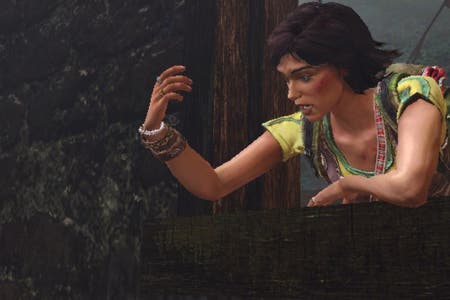Tech Analysis: Uncharted: Golden Abyss
Where no handheld has gone before.
Given the task of translating the much-beloved Uncharted franchise to Sony's shiny new portable, Bend Studio - best known for the Syphon Filter games on PSP - has taken on a huge weight of responsibility from the original series creators at Naughty Dog. By entrusting the team with the engine that drives the three console games, alongside a degree of freedom over the back-story of its leading characters, Uncharted: Golden Abyss sets out to be a fully-fledged adventure that is both essential to fans of the series, as well as early Vita adopters looking to showcase their handheld's graphical prowess.
In our recent Digital Foundry vs. PlayStation Vita feature our first impressions of the game were highly favourable, but when it comes down to the finer details, just how comparable is Golden Abyss to the home console entries in the series? Are we truly seeing PS3-quality gaming on a handheld machine, and at launch no less?
The Resolution Issue
From the off, we know that the game needs only to output at a maximum resolution of 960x544, known in abbreviated form as quarter High Definition (qHD). This is an immediate saver on GPU fill-rate when compared to the home console renditions, each running at 1280x720 with various implementations of AA, so this should theoretically lighten the processing burden on the Vita from the start. On close inspection, however, it appears that a great bulk of early titles released for the handheld still settle for sub-qHD native resolutions before being upscaled, with Uncharted being set at 720x408.
"Just how comparable is Golden Abyss to the home console entries in the Uncharted series? Are we truly seeing a PS3-quality gaming experience on a handheld machine, and at launch no less?"
This is lower than we had expected, and although the actual content of the game is often a marvel to behold, it does muddy the overall image quality more than we'd prefer. The pixel-perfect crispness we see in other launch games like Ultimate Marvel vs. Capcom 3, Dynasty Warriors NEXT and Virtua Tennis 4 simply isn't on show here. This basically means that Golden Abyss is one of the go-to games for showcasing raw processing power of the Vita, while the task of demonstrating the clarity of the console's beautiful OLED screen would probably be better served by the other games mentioned, which are all 1:1 with its maximum resolution.
You can see the obvious scaling in the screenshots dotted throughout this feature, but what we should point out straight from the off is that Vita's pixel density is most likely far greater than what you have on your screen. So the upscaling is noticeable on the small screen, but it's far more of an issue when blown up on the average PC display.

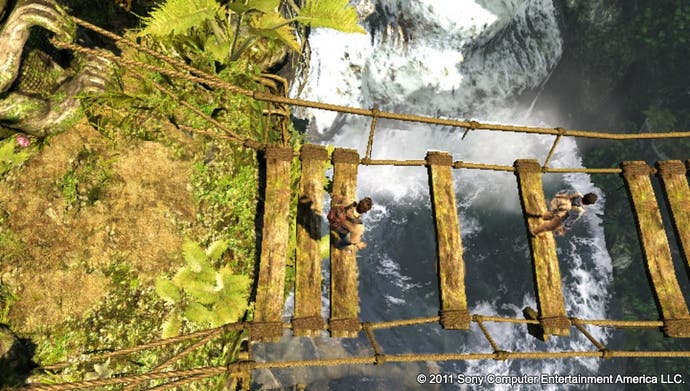
The other byproduct of reducing the internal framebuffer - a decrease to approximately 56 per cent of its full potential capacity - is that aliasing is now more apparent, typically on the high-contrast edges we see on the gold-coloured poles or ledges you're encouraged to climb throughout the game. We have to wonder whether a more effective anti-aliasing solution would have helped here, or if one will become available for future titles should they choose to go this sub-qHD route again.
Lighting, Shadows and Particles
On the plus side, everything contained within that lower-resolution window looks very impressive, and worth making concessions for. The lighting in particular is outstanding, with a level of global illumination being applied across large jungle environments that adds greatly to the feeling of a living, breathing place of nature.
"The level of environmental detail is eye-popping and although light sources are generally static, the overall quality of illumination in-game is remarkable for a handheld title."
One of the biggest visual highlights of Golden Abyss is seeing light patches pass through onto Drake's back as he runs through these enclosed jungle pathways, and likewise during cave levels, where occasional spots of light shine through crevices. Leaves also reveal a transparent property, which enables you to see on which parts of each individual blade on a tree the lighting and shadows falls on - a very nice touch.
We notice that the lighting doesn't always sit well with characters at times though, usually when object-based lighting sources like the portable torch come into play in darker levels. This may be for design purposes, but Drake and his allies seem slightly lighter - as if contoured by a thin line that divides the logic of the lighting engine - than their environments, which may be to outline their place in the game to make them easier to pick out.
By comparison, the lighting during the brighter jungle levels offers a massive increase in quality in this regard, with characters no longer appearing as "cut out" as before. The way that lighting is handled comes across as downgraded by comparison to Uncharted 2/3's approach overall, with the shadows that are dynamically cast looking noticeably lower in resolution, and prone to visible flickering close up too.

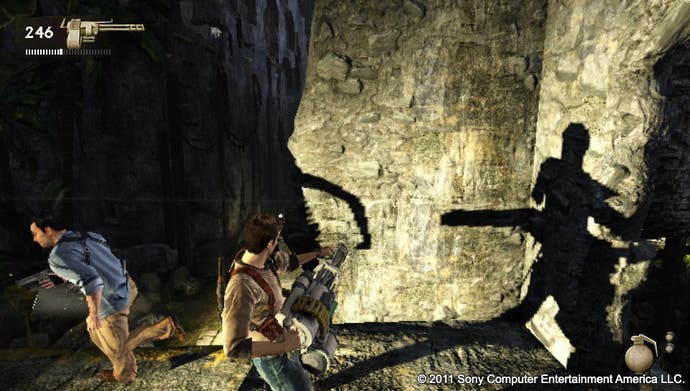
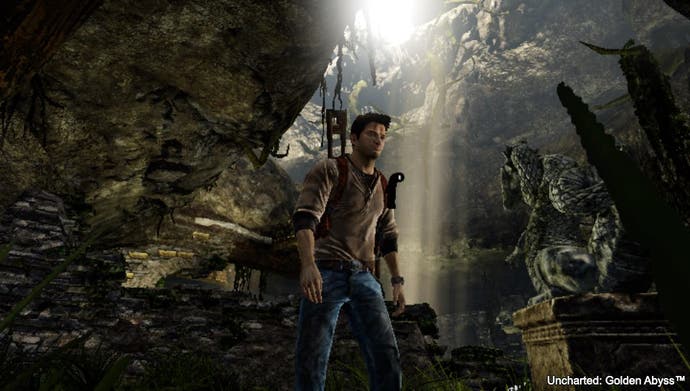

"Bend Studio has nipped and tucked at Uncharted's visuals, reducing resolution, paring back alpha and particle effects and changing the lighting - but the overall look is still very impressive overall."
Another big "wow" moment in Golden Abyss would undoubtedly be the first sight of its water effects, utilising a shader that does seem to be very close to what we've seen in other recent games in the series. Bend Studio has integrated this as much as it can into the gameplay, with several swimming and boat segments included to mix up the formula usually dominated by shootouts, climbing and puzzle-solving. Although these sections can often be as spectacular as they are on PS3, the reflections in rivers appear to be solely focused on light sources, with the reflections of surrounding geometry excluded. Regardless, it's still a high point of the game's visual make-up.
On the less impressive end of the spectrum, there are a few egregious nips and tucks to the way alpha effects and particles are handled. Specifically, the fire effects we see in an early chapter involving a burning prison cell level are no longer transparent, making them seem much flatter by comparison to the licking flames we see in Uncharted 3's burning chateau stage. In this respect we're reminded of the opaque explosions in the original Uncharted: Drake's Fortune. We've published a range of screenshots embedded into the article, but you can find those and a bunch more in an additional Uncharted: Golden Abyss screenshot gallery.
There also seems to be a pixellation surrounding the alpha effect used on waterfalls - for both the water running downwards and the steam rising upward - which are running at an even lower-resolution buffer than the rest of the game. This is easy to spot when positioning Drake directly in front of the waterfall in the earliest jungle stage, creating a distinct separation in fidelity between foreground and background elements. Particle effects, such as bullet ricochets on walls and explosion debris, appear to suffer from this too - although these aren't quite so noticeable due to their relative impermanence in a scene.

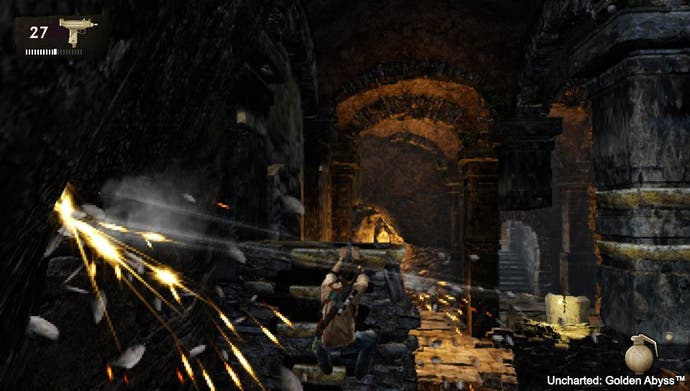

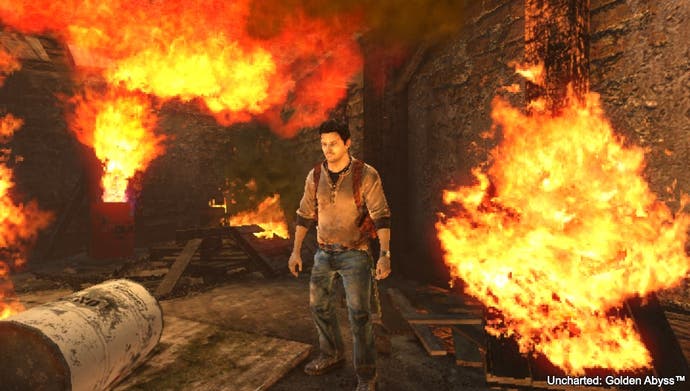
Motion Capture and Animation
"The same motion-capture techniques and technology that worked so well in the PS3 Uncharted games is just as good on Vita, by and large. These are the most impressively realised in-game characters we've seen in a handheld game."
Perhaps one of the most celebrated achievements of the Uncharted series is its seamless use of motion-capture, which, alongside a clever dynamic animation system used for transitions between ducking, rolling and jumping, breathes life into its cast during both cut-scenes and gameplay. For a portable title, it's great to see Bend Studio go the extra mile to maintain the series' traditional approach to creating these cut-scenes. The motion-captured segments once again fully involve the body and voice acting talents of the ubiquitous Nolan North, alongside a cast of actors both new and old, who enthusiastically flesh out an adventure every bit as long and winding as Uncharted 2 and 3.
The writing and directing talents may have been switched out, but as we see in this recent making-of video (warning: reveals a character who only appears midway through the game, so somewhat spoilerific), the philosophy behind creating these scenes remains quite the same. The facial animation is also spot-on in most cases, although much of the character development that goes on is told through dialogue rather than shown through gesture, and so isn't really used to its fullest effect.
There are also some beats in Golden Abyss' storyboard which haven't been rendered with the same level of care and attention. We notice that in one early stage a jeep comes crashing through a gate, forcing Drake to jump to lower ground where a crude, quick approximation of the movement is used rather than full motion-capture. Although rare, these jarring transitions suggest that the overall polish level of the portable game isn't quite up to the standards of a full Naughty Dog epic.
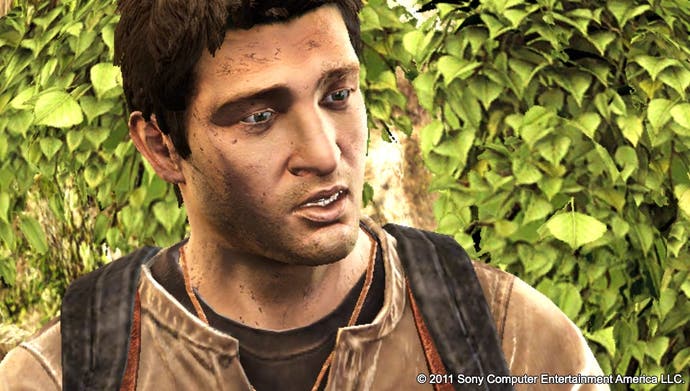
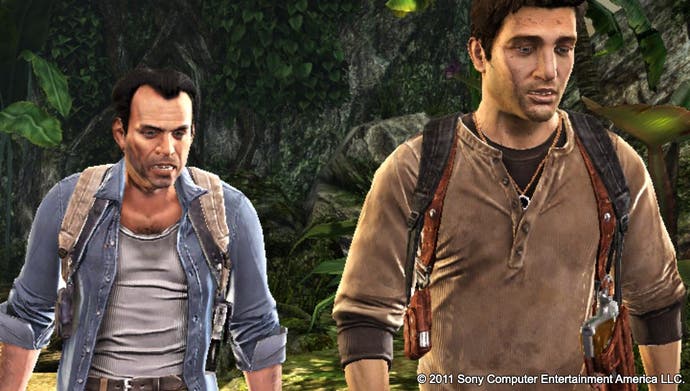

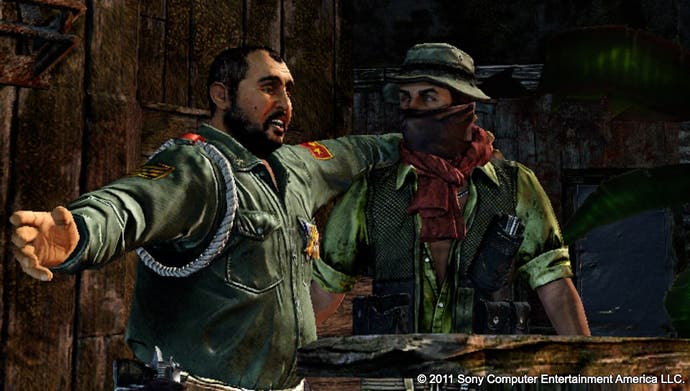
The heavily engineered set-pieces that have come to define the series are practically non-existent in this entry, with the drama for the most part being developed through some ledge-breaking, branch-snapping moments during the climbing sections. The animation system works just as well as ever, with Drake leaning towards the next viable point of purchase, and fumbling whenever a surface crumbles at his fingers. These points of panic are sometimes punctuated by the use of a touch-screen based quick-time event, during which you have to immediately drag your finger up the screen to regain grip. You could describe it as a more economical approach to set-piece design.
"Golden Abyss feels almost like 'Uncharted 1.5' - shorn of the set-pieces of the later games, but highlighting the strengths of the core gunplay and traversal mechanics."
However, after the "experience-driven" action of Uncharted 3, we'd say the difference here is a welcome change of pace. Naughty Dog's angle on the Uncharted series as of late involves putting a heavy priority on constructing gigantic blockbuster moments, such as the capsizing cruise ship in UC3, and then finding a way to work them into the narrative. Bend Studio may not have had the time or experience with the new hardware to pull this off, so it's really much more story-driven here - like the very first Uncharted in many ways. This in a sense means there's less emphasis on overt spectacle, but more coherence as far as pairing the setting with its story. We still miss Naughty Dog's set-pieces, of course, but some may appreciate the different pace Golden Abyss operates at as a result of their removal - and it serves to demonstrate how fundamentally satisfying the core gunplay and traversal mechanics are.
Speaking of animation during shootouts, we do notice that some of Drake's moves don't flow nearly as dynamically as in previous adventures. This is likely to attract the attention of long-time fans of the series, well-versed in the minutiae of its mechanics by this point. In particular, rolling from cover is now a more laboured process, with a press of the circle button only detaching Drake from his position and not allowing you to follow up with another action immediately. This is in stark contrast to the fluid motion system in Uncharted 3, which permits jumping, reloading, rolling and slide-to-cover animations to occur in quick succession if necessary, all elegantly wrapped up in a single sequence. Here, most moves need to be enacted in a stricter order.
So why the change? At the end of the day, Golden Abyss is an exercise in repurposing a game created for a more powerful system onto a handheld and compromises are a necessary evil. Vita's quad-core Cortex-A9 CPU obviously falls short when compared to the 3.2GHz PPU and seven active SPUs on the PS3's Cell. The layered animation system used by the series since the Drake's Fortune days requires these SPUs to decompress and blend 60 or more basic animations together on Drake. It would seem that the rolling and jumping animations in Golden Abyss revolve around a pre-baked approach, explaining the lack of flexibility during each command, as opposed to the more demanding, procedural, real-time method seen in the home console versions.
Geometry, Physics and Performance
The smoothness of the gameplay is gravely affected in another way too: namely, in terms of the diminishing standards of performance as you progress through its many chapters. Our early impressions were positive on this point, having played through the first batch of jungle levels and not experiencing much in the way of hits to the frame rate, even during the more intensive shootouts. Similarly, cut-scenes appear to run without a hitch for the entire duration of the game, with almost every single one locked at an unerring 30FPS.
"The general performance level seems to drop somewhat in the game's later stages: frame-rate stutters and control response suffers as a consequence."
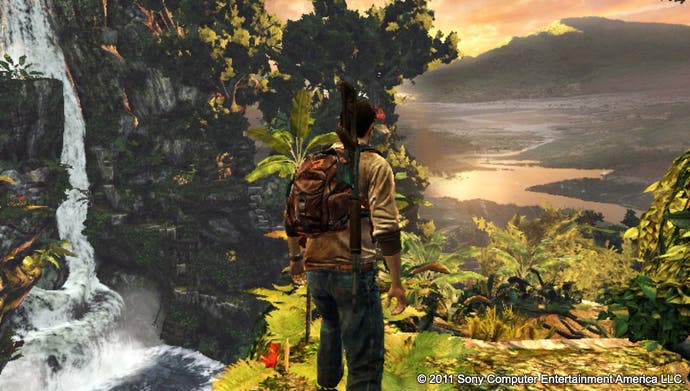
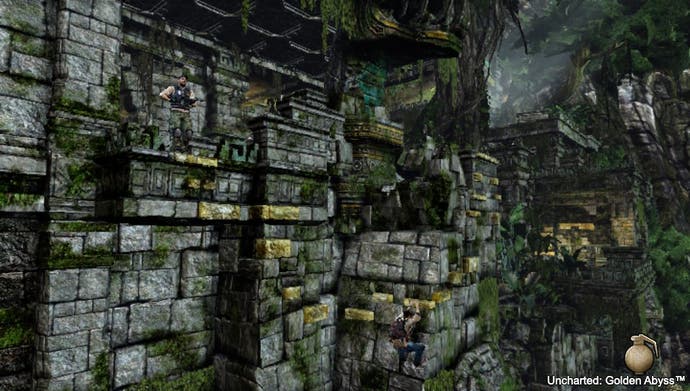
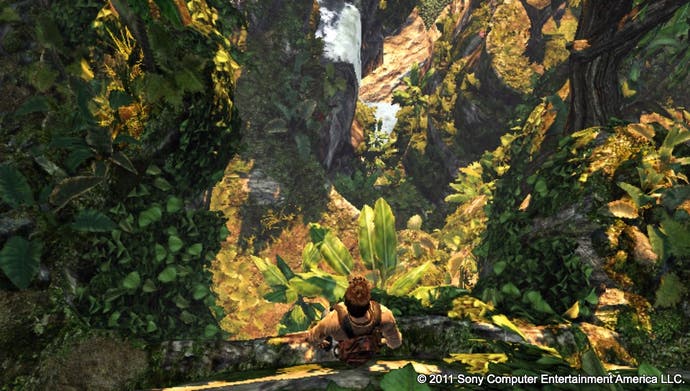
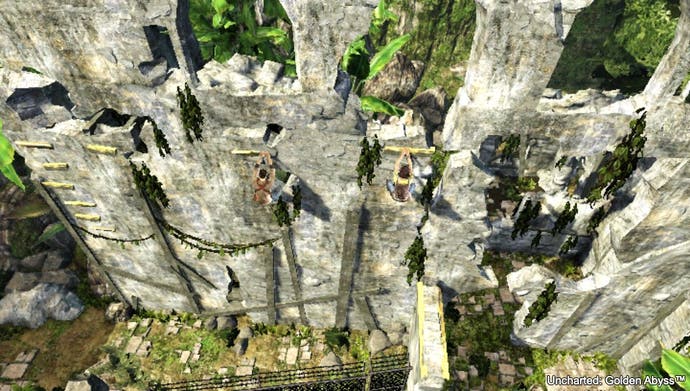
Sadly, a similar effort to optimise for performance has not been made to the later levels, and it feels like stuttering becomes a more frequent occurrence as the shootouts get bigger and wilder, resulting in a hit to input response. By the second half of the game, we find that everything runs smoothly enough until three or more enemies begin populating the more ambitious environments, by which point the frame-rate can dip to the 20FPS mark for protracted spells. The problem appears to be related to this level of enemy activity being combined with larger, more complicated geometry used in such environments. It's almost as if these ornate areas were designed to suit the processing budget exactly, without accounting for the additional load that more character models might invoke.
Meanwhile, physics-based action tends to be handled convincingly at no major charge to performance, although it is largely under-emphasised in Golden Abyss. There are only a handful of specific areas where running into crates causes them to roll, but for the most part objects littering indoors environments remain static, while tree branches are typically made inaccessible to you via an invisible wall. We do see some impressive deterioration to scenery during traversal - usually in scripted instances - where rocks and ledges on a wall tumble downwards, but this isn't pushing the boundaries of what might be possible with the engine.
New Console, New Control Possibilities
PlayStation Vita offers several new methods of control which sets the style of play apart from the console iterations of the series - specifically through its use of the front and rear touch controls, camera, and the included gyrometer and accelerometer sensors. To the chagrin of traditionalists, many of these input methods are entirely obligatory, with the front touch-screen being the most regularly used. This is for such activities as charcoal rubbing, rotating safety locks through multi-touch, and cleaning off dirt from relics, where the rear touch panel is used to spin the object at different angles while the thumbs do their work.
"Touch-screen controls additions are a mixed bag: melee combat, sniper-scope adjustment and puzzle mini-games work well but the plank-walking balancing act was best left behind in Uncharted 1."
These are entertaining enough to begin with, but activities such as the charcoal rubbing are perhaps a tad overused by the end of the game, where you're expected to do it six times in a row at one point. Puzzles are aided greatly by the touch-screen, however, with the placement of different blocks or torn pieces of a map being much easier to rotate and position than we'd imagine a conventional control method could approximate. Another touch we liked was the ability to use either the front or rear touch-screens for zooming in and out with the sniper scope - an example of how touch can be incorporated seamlessly to improve the interface between the player and the game.
The gyrometer controls are also offered as an optional aiming scheme to be used in tandem with the analogue sticks, and as with Killzone 2, this allows you to make minute tweaks to the reticle if necessary. Given that aiming via the sticks alone can be a little cumbersome at times, using this in conjunction is an entirely viable way to play through the game.
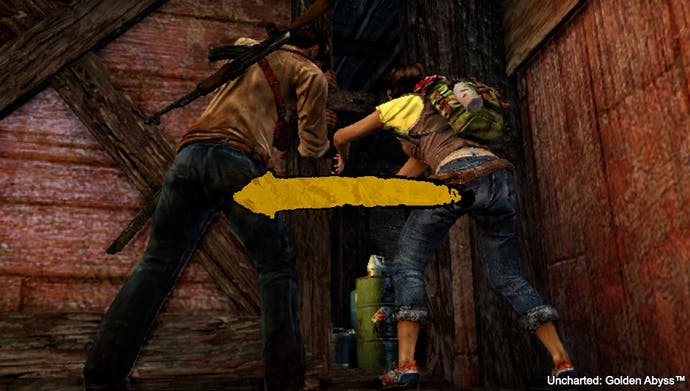
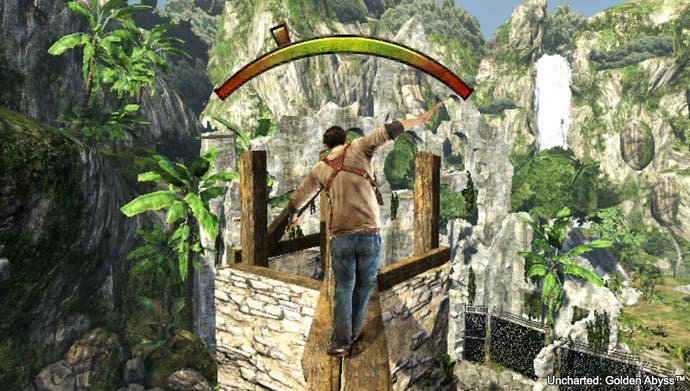
Integral commands such as picking up weapons and grenades, as well as engaging in melee combat, are offered on the touch-screen as alternatives to their dedicated buttons. In the latter case, you're actually required to swipe the screen in a direction to avoid being hit by the enemy by the end of a combo, before swiping again for your riposte. This actually works pretty well, and we found that it was easier to start a melee chain using the touch-screen exclusively to avoid confusing the inputs.
Grenades have no such dedicated physical button to fall back on this time, with the omission of the L2 and R2 shoulder buttons forcing use of the touch-screen. The new controls are intuitive enough, with a grenade's trajectory being drawn by dragging the icon in the corner towards an enemy, and then releasing to lob it across. We're less enthused by the idea of using the gyrometer controls to balance Drake as he walks across thin planks though - an idea that makes an unwelcome return after being ditched in the very first Uncharted, and breaks up the flow of gameplay in a fairly annoying manner.
Uncharted: Golden Abyss - the Digital Foundry Verdict
"As a launch title on brand new hardware, this is the kind of game Vita owners will be compelled to play purely to make an early judgement call on whether the new control methods are an appropriate fit, and to sample the console's graphical potential."
Uncharted: Golden Abyss seems almost akin to an 'Uncharted 1.5' in many ways. Many of the core engine enhancements of the second game are included, such as the permanently engaged v-sync and improved AI for stealth sections, but it does lack the grandiose set-pieces the series has become renowned for. The Vita also struggles to keep the game running at a solid 30FPS, particularly when too many enemies are involved - despite the cutbacks made by way of the decreased internal framebuffer, the pared back animation system, and the lower resolution alpha effects.
Nevertheless, as a launch title on brand new hardware, this is the kind of software Vita owners will be compelled to play purely to make an early judgement call on whether the new control methods are an appropriate fit, and to sample the console's graphical potential. With a long campaign to play through, backed up by fully motion captured cut-scenes and some great action, Golden Abyss is far more than just the tech demo it might have been were a lesser studio involved.
However, if we're putting it side by side with other games in the franchise, it must be said that the performance issues and compromises to image quality issues lessen its appeal a touch. Even respecting that this is for a weaker, portable device, the high standards of optimisation and polish set by each of Naughty Dog's games has not been matched here, and we do wonder if the Bend team simply ran out of time here. Regardless, in the context of mobile gaming in general, the technical accomplishment here is remarkable, and while Drake's latest adventure may not be his greatest, it's clearly one of the best releases in Vita's impressive launch line-up.
